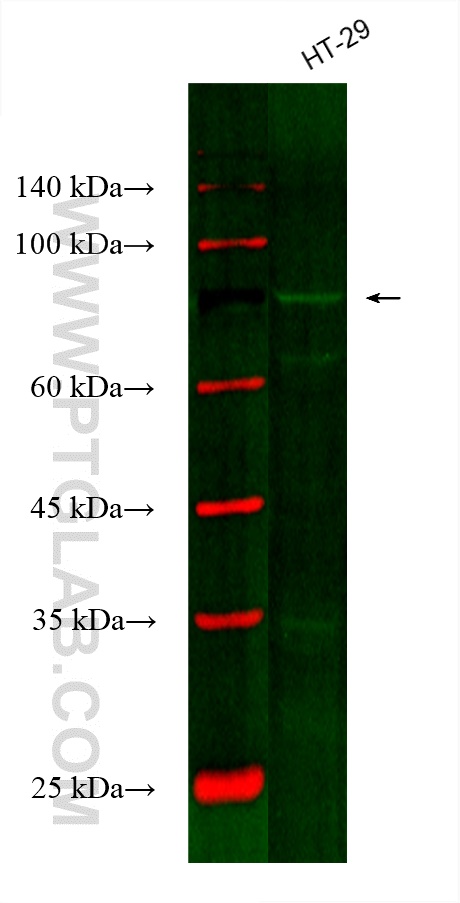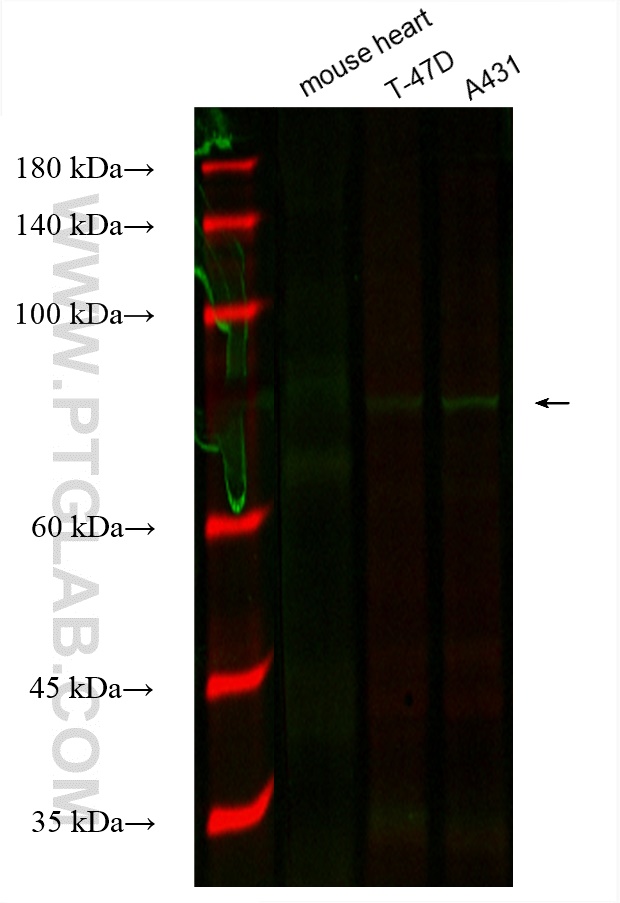验证数据展示
经过测试的应用
| Positive WB detected in | HT-29 cells, T-47D cells |
推荐稀释比
| 应用 | 推荐稀释比 |
|---|---|
| Western Blot (WB) | WB : 1:500-1:1000 |
| It is recommended that this reagent should be titrated in each testing system to obtain optimal results. | |
| Sample-dependent, Check data in validation data gallery. | |
产品信息
CL488-66445 targets Gamma Catenin in WB applications and shows reactivity with human, rat, pig, Canine samples.
| 经测试应用 | WB Application Description |
| 经测试反应性 | human, rat, pig, Canine |
| 免疫原 | Gamma Catenin fusion protein Ag1627 种属同源性预测 |
| 宿主/亚型 | Mouse / IgG1 |
| 抗体类别 | Monoclonal |
| 产品类型 | Antibody |
| 全称 | junction plakoglobin |
| 别名 | ARVD12, Catenin gamma, CTNNG, Desmoplakin 3, Desmoplakin III, DP3, DPIII, junction plakoglobin, JUP, PDGB, PKGB, γ-Catenin |
| 计算分子量 | 82 kDa |
| 观测分子量 | 82 kDa |
| GenBank蛋白编号 | BC011865 |
| 基因名称 | Gamma Catenin |
| Gene ID (NCBI) | 3728 |
| RRID | AB_3084247 |
| 偶联类型 | CoraLite® Plus 488 Fluorescent Dye |
| 最大激发/发射波长 | 493 nm / 522 nm |
| 形式 | Liquid |
| 纯化方式 | Protein G purification |
| UNIPROT ID | P14923 |
| 储存缓冲液 | PBS with 50% glycerol, 0.05% Proclin300, 0.5% BSA , pH 7.3 |
| 储存条件 | Store at -20°C. Avoid exposure to light. Stable for one year after shipment. Aliquoting is unnecessary for -20oC storage. |
背景介绍
Plakoglobin (γ-catenin), a member of the Armadillo proteins, plays important roles in cell adhesion with α-catenin and β-catenin, is involved in Wnt signaling, and is translocated into the nucleus and binds LEF1. Plakoglobin is a major cytoplasmic component of both desmosomes and adherens junctions, and is the only known constituent common to submembranous plaques in both of these structures, which are located at the intercalated disc (ICD) of cardiomyocytes. Plakoglobin links cadherins to the actin cytoskeleton. Mutations in plakoglobin are associated with arrhythmogenic right ventricular dysplasia and Pemphigus vulgaris.
实验方案
| Product Specific Protocols | |
|---|---|
| WB protocol for CL Plus 488 Gamma Catenin antibody CL488-66445 | Download protocol |
| Standard Protocols | |
|---|---|
| Click here to view our Standard Protocols |

